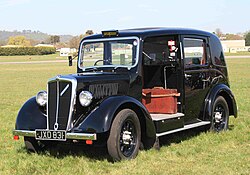Wolseley Oxford Taxi
| Wolseley / Nuffield | |
|---|---|
|
Nuffield Oxford Taxi (1st series)
|
|
| Oxford taxi | |
| Production period: | 1947-1955 |
| Class : | Middle class |
| Body versions : | Pullman limousine |
| Engines: |
Otto engine : 1.8 liters (25.7 kW) |
| Length: | 4255 mm |
| Width: | 1676 mm |
| Height: | |
| Wheelbase : | 2731 mm |
| Empty weight : | |
| Previous model | Morris Commercial Taxicab |
The Wolseley Oxford Taxi (or Nuffield Oxford Taxi ) was the first new taxi to hit the British market after the end of World War II .
The Morris construction- based prototype was built in 1940 and collected approximately 160,000 km for testing purposes before production began in February 1947. It was the first "new" design to be unveiled at the Ward End factory in Birmingham , the seat of Wolseley Motor Company since 1919. The cars were produced until 1955, when the Austin FX3 introduced in 1948 replaced the model. This was a much more modern car and was manufactured in larger numbers.
An in-line four-cylinder gasoline engine with 1802 cc and an output of 35 bhp (25.7 kW), the design of which was still based in part on that of the Morris Oxford from the 1920s, powered the Oxford Taxi. The brakes were mechanically operated by tie rods and the rear axle had a worm drive.
There were three versions:
- The Mark I (1947) had wooden spoke wheels.
- The Mark II (1949) was a "Six Light" for the private taxi industry.
- The Mark III (1950) was a revised Mark I with steel disc wheels.
Most of the vehicles were sold through the London dealer Beardmore . About 1800 pieces were made.
Individual references and comments
- ↑ a b History of the Ward-End Factory (English). ( Memento of December 30, 2007 in the Internet Archive )
- ↑ Michael Sedgewick: AZ of Cars 1945-1970 , Bay View Books, Devon (1986), ISBN 1-870979-39-7
- ↑ a b Taxi brands and models (English)
- ↑ A “Six Light” has three windows on each side, usually one in each door and a small window in the C-pillar.
